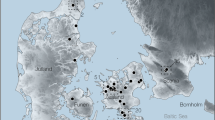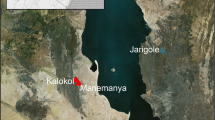Abstract
Examination of African barbed bone points recovered from Holocene sites provides a context to interpret three Late Pleistocene occurrences from Katanda and Ishango, Zaire, and White Paintings Shelter, Botswana. In sites dated to ca. 10,000 BP and younger, such artifacts are found widely distributed across the Sahara Desert, the Sahel, the Nile, and the East African Lakes. They are present in both ceramic and aceramic contexts, sometimes associated with domesticates. The almost-universal presence of fish remains indicates a subsistence adaptation which incorporates a riverine/lacustrine component. Typologically these points exhibit sufficient similarity in form and method of manufacture to be subsumed within a single African “tradition.” They are absent at Fayum, where a distinct Natufian form occurs. Specimens dating to ca. 20,000 BP at Ishango, possibly a similar age at White Paintings Shelter, and up to 90,000 BP at Katanda clearly fall within this same African tradition and thus indicate a very long-term continuity which crosses traditionally conceived sub-Saharan cultural boundaries.
L'étude des pointes barbelées en os del' Holocène africaine fournit un contexte à l'interprétation de trois gisements du Pleistocene superieure, notamment, Katanda et Ishango (en République Démocratique du Congo, ex-Zaire), et White Paintings Shelter au Botswana. Cettes pointes ont une distribution étendue à travers le Sahara, le Sahel, le Nil et les grands lacs du rift d'Afrique orientale, notamment sur certains sites datant de 10,000 ans avant notre ère. Ces pointes sont associées avec des types d'industries céramiques ou acéramiques, avec ou sans squelettes de faune domestiques, mais toujours avec des squelettes de poisson, indiquent une subsistence comportant des ressources lacustres ou riveraines. Sur le plan typologique, cettes pointes présentent une telle ressemblance, soit de forme, soit de manufacture, qu'elles constituent une tradition unique africaine. Au Fayum en Egypte, les formes des pointes rappellent, par contre, plutôt les series Natufiennes du Levant. Les pointes barbelées d'Ishango, datant de 20,000 ans environ, celles de White Paintings Shelter, datant probablement de la même époque, et celles de Katanda datant au maximum de 90,000 ans BP, appartiennent à la même tradition africaine, ce qu montre ainsi l'existence d'une continuité de très longue durée àtravers les frontières culturelles traditionelles.
Similar content being viewed by others
REFERENCES
Adamson, D., Clark, J. D., and Williams, M. A. J. (1974). Barbed bone points from Central Sudan and the age of the “Early Khartoum” tradition. Nature 249: 120–123.
Aigner, J. S. (1966). Bone tools and decorative motifs from Chaluka, Umnak Island. Arctic Anthropology 3(2): 57–83.
Arkell, A. J. (1949). Early Khartoum, Oxford University Press, London.
Arkell, A. J. (1953). Shaheinab, Oxford University Press, London.
Barthelme, J. W. (1977). Holocene sites northeast of Lake Turkana: A preliminary report. Azania 12: 33–41.
Barthelme, J. W. (1985). Fisher-Hunters and Neolithic Pastoralists in East Turkana, Kenya, British Archaeological Reports International Series 254, Oxford.
Boaz, N. T., Pavlakis, P., and Brooks, A. S. (1990). Late Pleistocene-Holocene human remains from Ishango, Zaire. In Boaz, N. T. (ed.), Evolution of Environments and Hominidae in the African Western Rift Valley, Virginia Museum of Natural History Memoir 1, Martinsville, pp. 273–299.
Breuil, H. (1903). Essai de stratigraphie des dépôts de l'Age de Renne. Congres Préhistorique de France, Perigeux, pp. 74–80.
Brooks, A. S., and Robertshaw, P. (1990). The glacial maximum in Tropical Africa: 22,000 to 14,000 BP. In Soffer, O., and Gamble, C. (eds.), The World at 18,000 BP, Unwin Hyman, London, pp. 119–169.
Brooks, A. S., and Smith, C. C. (1987). Ishango revisited: New age determinations and cultural interpretations. African Archaeological Review 5: 65–78.
Brooks, A. S., Helgren, D. M., Cramer, J. S., Franklin, A., Hornyak, W., Keating, J. M., Klein, R. G., Rink, W. J., Schwarcz, H., Smith, J. N. L., Stewart, K., Todd, N., Verniers, J., and Yellen, J. E. (1995). Dating and context of three Middle Stone Age sites with bone points in the Upper Semliki Valley, Zaire. Science 268: 548–553.
Brown, F. H. (1975). Barbed bone points from the Lower Omo Valley, Ethiopia. Azania 10: 144–148.
Butzer, K. W., Isaac, G. L., Richardson, J. L., and Washburn-Kamari, C. (1972). Radiocarbon dating of East African lake levels. Science 175: 1069–1076.
Camps, G. (1974). Les Civilisations préhistoriques de l'Afrique du Nord et du Sahara, Doin, Paris.
Camps, G. (1982). Beginnings of pastoralism and cultivation in North-west Africa and the Sahara: Origins of the Berbers. In Clark J. D. (ed.), Cambridge History of Africa, Vol. 1. From the Earliest Times to c. 500 17. B.C., Cambridge University Press, Cambridge, pp. 548–657.
Camps-Fabrer, H. (1968). Industrie Osseuse Epipaléolithique et Néolithique du Maghreb and du Sahara, 7th cahier, Fiches 200–225, Fiches typologique Africaines Arts et Graphiques, Paris.
Camps-Fabrer, H. (1983). Paures et Engins de Peche. In Petit-Marie, N., and Riser, J. (eds.), Sahara ou Sahel? Laboratoire de Geologie du Quarternaire du Centre National de la Recherche Scientifique, Paris, pp. 367–410.
Caton-Thompson, G., and Gardner, E. W. (1934). The Desert Fayum, Royal Anthropological Institute 2, London.
Clark, J. D. (1989). Shabona: An early Khartoum settlement on the White Nile. In Krzyzaniak, L., and Kobusiewicz, M. (eds.), Late Prehistory of the Nile Basin and the Sahara, Studies in African Archaeology, Vol. 2, Poznan, pp. 387–410.
Davies, O. (1973). Excavations at Ntereso, Gonja, Northern Ghana, Pietermaritzburg.
Deffarge, R, Laurent, P., and de Sonneville-Bordes, D. (1974). Les harpons de l'Abri Morin. In Camps-Fabrer, H. (ed.), L'industrie de l'os dans la préhistoire, Editions de l'Universite de Provence, pp. 193–218.
de Heinzelin, J. (1957). Les Fouilles d'Ishango, Exploration du Parc Nationale Albert, Fasc. 2, Institut des Parcs Nationaux du Congo Belge, Brussels.
de Heinzelin, J. (1962). Ishango. Scientific American 26: 105–116.
de Heinzelin, J., and Verniers, J. (1996). Realm of the Upper Semliki (Eastem Zaire): An Essay on Historical Geology, Annales du Musée Royal de l'Afrique Centrale, Sciences Geologiques, Vol. 102, Tervuren.
Drucker, P. (1943). Archaeological survey on the northern Northwest Coast. Anthropological Papers 20, Bulletin 133, Smithsonian Institution, Washington, DC, pp. 17–142.
Gallay, A. (1966). Quelques gisements neolithiques du Sahara Malien. Journal de la Sociétié des Africanists 36(2): 167–208.
Haaland, R. (1995). Sedentism, cultivation and plant domestication in the Holocene Middle Nile Region. Journal of Field Archaeology 22: 157–174.
Hassan, F. (1986). Chronology of the Khartoum “Mesolithic” and “Neolithic” and related sites in the Sudan: Statistical analysis and comparisons with Egypt. African Archaeological Review 4: 83–102.
Khabir, A. M. (1987). New radiocarbon dates for Sarurab 2 and the age of the Early Khartoum tradition. Current Anthropology 28: 377–380.
Knecht, H. (1994a). Projectile points of bone, antler and stone: Experimental explorations of manufacture and function. Unpublished paper presented at the Society for American Archaeology, Anaheim.
Knecht, H. (1994b). The use of bone and antler as the raw materials of projectile point Manufacture during the Early Upper Paleolithic. Unpublished paper presented at the Paleoanthropology Society, Anaheim.
Livingstone, D. A. (1980). Environmental changes in the Nile headwaters. In Williams, M. J. J., and Faure, H. (eds.), The Sahara and the Nile. Quaternary Environments and Prehistoric Occupation in Northern Africa, A. A. Balkema, Rotterdam, pp. 339–359.
Marks, A. E., and Mohammed-Ali, A. (1991). The Late Prehistory of the Eastem Sahel. Southern Methodist University Press, Dallas.
Marshall, F., Stewart, K., and Barthelme, J. (1984). Early domestic stock at Dongodien in northern Kenya. Azania XIX: 120–127.
Mason, O. T. (1900). Aboriginal American Harpoons: A Study in Ethnic Distribution and Invention, Report U.S. National Museum, Washington, DC, pp. 189–305.
Monod, T., and Mauny, R. (1957). Decouverte de nouveaux instruments en os dans l'Ouest Africain. In Clark, J. D., and Cole, S. (eds.), Third Pan-African Congress on Prehistory. Livingstone, Chatto and Windus, London, pp. 242–247.
Nelson, C. M. (1991). Harpoon evolution on the spit (GaJi12) at Koobi Fora, Lake Turkana, Kenya. Nyame Akuma 36: 10–14.
Newcomer, M. H. (1974). Study and replication of bone tools from Ksar Akil (Lebanon). World Archaeology 6(2): 138–153.
Petit-Marie, N., Celles, J. C., Commelin, D., Delibrias, G., and Raimbault, M. (1983). The Sahara in northern Mali: Man and his environment between 10,000 and 3,500 years BP. African Archaeological Review 1: 105–126.
Phillipson, D. W. (1977). Lowasera. Azania 12: 1–32.
Phillipson, D. W. (1982). Early food production in sub-Saharan Africa. In Clark, J. D. (ed.), Cambridge History of Africa, Vol. 1. From the Earliest Times to c. 500 B.C., Cambridge University Press, Cambridge, pp. 770–829.
Robbins, L. H. (1974). The Lothagam Site: A Late Stone Age Fishing Settlement in the Lake Rudolf Basin, Kenya, Michigan State University Museum, Anthropology Series 1(2). Publications of the museum—Michigan State University, Lithographers, Ann Arbor.
Robbins, L. H. (1980). Lopoy: A Late Stone Age Fishing and Pastoralist Settlement West of Lake Turkana, Kenya, Michigan State University Museum Anthropology Series 2(1). Publications of the museum—Michigan State University, Lithographers, Ann Arbor.
Robbins, L. H., Murphy, M. L., Stewart, K. M., Campbell, A. C., and Brook, G. A. (1994). Barbed bone points, paleoenvironment, and the antiquity of fish exploitation in the Kalahari Desert, Botswana. Journal of Field Archaeology 21: 257–264.
Roset, J. P. (1987). Paleoclimatic and Cultural Conditions of Neolithic Development in the early Holocene of Northern Niger (Aïr and Ténéré). In Close, A E. (ed.), Prehistory of Arid North Africa, Southern Methodist University Press, Dallas.
Servant, M., and Servant-Vildary, S. (1980). L'environnement quaternaire du bassin du Tchad. In Williams, M. A. J., and Faure, H. (eds.), The Sahara and the Nile: Quaternary Environments and Prehistoric Occupation in Northem Africa, A. A. Balkema, Rotterdam, pp. 133–162.
Simek, J. F. (1983). Preliminary studies of functional variability reflected in Upper Magdalenian barbed point shape, Unpublished manuscript.
Stow, G. W. (1905), The Native Races of South Africa, Macmillan, New York.
Sutton, J. E. G. (1974). The aquatic civilization of middle Africa. Journal of African History 15: 527–546.
Sutton, J. E. G. (1977). The African acqualithic. Antiquity 51: 25–34.
Thomas, D. S. G., and Shaw, P. A (1991). The Kalahari Environment, Cambridge University Press, Cambridge.
Troeng, J. (1993). Worldwide Chronology of Fifty-Three Prehistoric Innovations, Acta Archaeologica Lundensia, Series IN8, 21, Almqvist and Wiksell International, Stockholm.
Twiesselmmann, F. (1958). Les Ossements Humaines du Gite Mesolithique d'Ishango, Exploration du pare Nationale Albert, Fasc. 5, Institut des Parcs Nationaux du Congo Belge, Brussels.
Wendorf, F., and Schild, R. (1976). Prehistory of the Nile Valley, Academic Press, New York.
Wendt, W. E. (1966). Two prehistoric archaeological sites in Egyptian Nubia. Postilla 102: 1–46.
Whitworth, T. (1965). Artifacts from Turkana, northern Kenya. South African Archaeological Bulletin 20: 75–78.
Yellen, J. E. (1998). Behavioural and Taphonomic patterning at Katanda 9: A Middle Stone Age Site, Kivu Province, Zaire, Journal of Archaeological Science (in press).
Yellen, J. E., Brooks, A. S., Cornelbsen, E., Mehlman, M., and Stewart, K. (1995). A Middle Stone Age worked bone industry from Katanda, Upper Semliki Valley, Zaire. Science 268: 553–556.
Author information
Authors and Affiliations
Rights and permissions
About this article
Cite this article
Yellen, J.E. Barbed Bone Points: Tradition and Continuity in Saharan and Sub-Saharan Africa. African Archaeological Review 15, 173–198 (1998). https://doi.org/10.1023/A:1021659928822
Issue Date:
DOI: https://doi.org/10.1023/A:1021659928822




